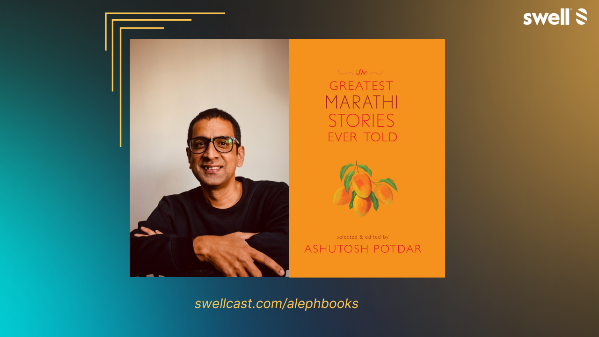
@Alephbooks
This is the offical Aleph Book Company Swellcast. We publish books of enduring literary quality. Pls visit:https://www.alephbookcompany.com/
The Greatest Marathi Stories Ever Told - In Conversation with Ashutosh Potdar.
Although India as a country produces a huge volume of what is called regional literature in its 23 odd regional languages, indian writers who write in these languages have to struggle to be heard and read in the circles of Indian readership. Though Peg debt just three to four per cent of the output of the Indian publishing industry history, translated works are slowly beginning to grab the attention of readers

Ashutosh Potdar
@Ashupotdar · 3:43
Speaking about different cultures, caste, classes, regions, dialects, professions, landscapes, peoplescapes. While working on this anthology a feeling was that I should share the stories with those who can't read Marathi. Or those who'd like to know about Marathi writing, Marathi short fiction or those who read Marathi that they would also enjoy reading the stories in English translation. They may feel different sometimes nice as well as reflective about the feel about the language that they have been reading since their childhood
So yeah, I loved your answer and as you mentioned in the introduction to your book book the geographical boundaries of Marathi short story form broadened post independence, new trends arose like Dalit literature and rural literature and so on and so forth, that verbalized a rebellious sentiment. Could you perhaps talk a little bit about the evolution of the Marathi short story over the years as literary form?
Swell Team
@Swell · 0:15

Ashutosh Potdar
@Ashupotdar · 4:48
Yeah, so? So the modern Marathi Lagukata the short story that we read today emerge from the journals and periodicals published during the 19th century print era. Now, the short story as a written form evolved through an interaction with indigenous narrative traditions, contemporary poetry, novel and social and political changes throughout 19th and 20th century. A freedom movement, Gandhianism and communism, and also heated debates about what is the purpose of literature. All this has been part of short story journey in Marathik

Ashutosh Potdar
@Ashupotdar · 3:23
So you read Marathi stories as reflected in this collection. What you get is the multilayeredness in the depiction of open hostility as well as circuit tensions existing within the structures, patriarchal structures, as well as other hierarchical structures of the society. And it is at the core of the reach repertoire of, say, women's writing that you will be reading in this collection as a representative of this women's writing through five stories included in this collection
Thank you so much for that deep dive into Marati short story. As a literary form, all the research that has gone behind the book comes to the forefront when you shared that reply. So, yeah, thanks for that. In your opinion, do you think stories and novels written in regional languages, while offering a closer look look at life in a particular region in some way ends up marginalizing its appeal?

Ashutosh Potdar
@Ashupotdar · 2:09
You see, it's not just about the region or a life in particular time and a space, but it's also about the larger framework of life, of framework of life, existence, human existence and politics within, again, kind of very broader framework. So instead of saying it like marginalizing, marginalizes its appeal, I would say it diversifies the appeal. The story diversifies the appeal. They are expressing different voices simultaneously and anchored within a certain location, time and space
I will leave you with one last question. Ashutosh. I recently read in an article about this balancing act that authors need to do while translating from regional languages to English, and that particular article referred to the art of translation as creativity within a defined space, and I couldn't agree more with that thought. The original writer has set the tone, context and the broad framework within which this translation process has to happen and the translator has to use his creativity within those framework

Ashutosh Potdar
@Ashupotdar · 1:35
Different translators in this volume have played with the English language with written imagination in order to flex, bend and stretch to and bring in marathon of the story. Being sensitive to the original writers and their values express in the stories, the translators have been very sensitive and faithful to the words, images, sounds, landscapes, ideas in the original text
Thank you for this great conversation. Ashutosh Potdar many insights, so much that you have unpacked in your responses, and I'm actually having this incredible urge to take a deep dive into Marathi literature to better understand the context and sociopolitical backdrop that gave us these wonderful stories. I'm going to be sharing the Amazon link of the book for our listeners to check out. I do hope to have you back on Swell for more literary conversations. So thanks again for your time and more power to your words


